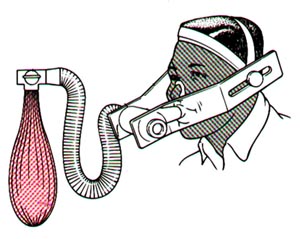 This
means that by measuring oxygen consumption during various activities we can
estimate energy expenditure.
This
means that by measuring oxygen consumption during various activities we can
estimate energy expenditure. Ideally, energy expenditure is measured by measuring heat output from the body. This is possible only using a thermally insulated chamber, which severely restricts the types of activity that can be performed, and it is usual to estimate energy expenditure indirectly, by measuring oxygen consumption.
To first approximation (and certainly within the limits of measuring oxygen consumption experimentally), there is an energy yield of 20 kJ (5 kcal) /L of oxygen consumed, regardless of the fuel being metabolised.
| energy yield | energy yield | oxygen | carbon dioxide | RQ | energy yield | energy yield | |
| kJ /g | kcal /g | L /g | L /g | kJ /L oxygen | kcal /L oxygen | ||
| carbohydrate | 16 | 4 | 0.829 | 0.829 | 1.000 | ~20 | ~5 |
| protein | 17 | 4 | 0.966 | 0.782 | 0.809 | ~20 | ~5 |
| fat | 37 | 9 | 2.016 | 1.427 | 0.707 | ~20 | ~5 |
 This
means that by measuring oxygen consumption during various activities we can
estimate energy expenditure.
This
means that by measuring oxygen consumption during various activities we can
estimate energy expenditure.
If we also measure carbon dioxide production, we can estimate the relative amounts of fat and carbohydrate being metabolised. This assumes that we ignore any oxidation of amino acids - for precision it would be necessary to estimate protein and amino acid metabolism by measurement of urinary urea excretion.
The percentage of energy derived from carbohydrate = ((RQ - 0.707) / (1 - 0.707))
x 100
and the percentage derived from fat = 100 - percentage from carbohydrate
In the simulation you will be shown oxygen consumption and carbon dioxide production for a subject walking at various speeds on a treadmill; using the data above, and the subject's BMR (which appears on the screen) you should be able to calculate the energy cost and PAR, as well as the relative amounts of carbohydrate and fat being metabolised.
Click here to open a printable version of the table.